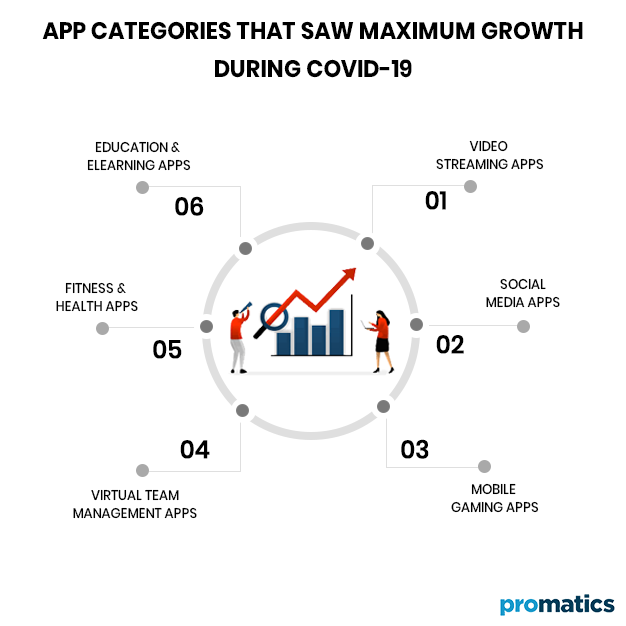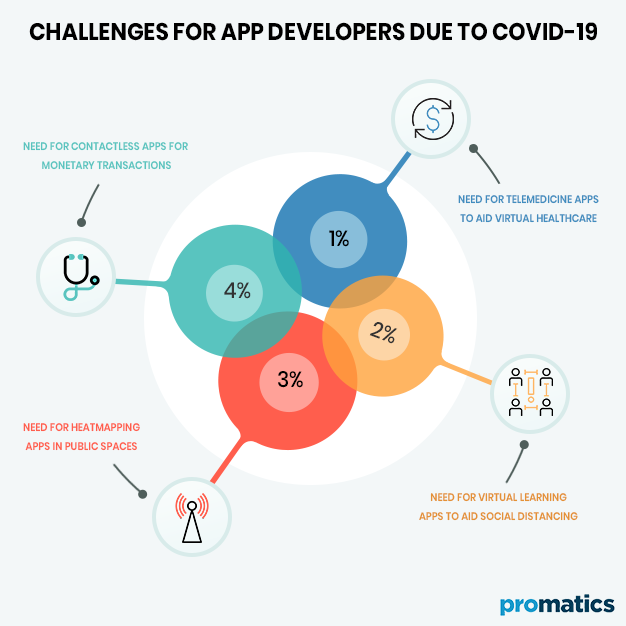The Changing Landscape of Mobile Apps in a COVID-19 World: Opportunities, Challenges, and Outlook
As a society, we are experiencing phenomenal shifts in how we are using our mobile handsets even for small tasks, given the social distancing norms levied on us. Consequently, mobile app development is too transitioning since COVID-19 raised its ugly face. While we would love to assume that the pandemic is just a phase, the changes in the world of mobile app development are seemingly permanent.
It is common for young entrepreneurs to feel drained during the current stagnation period. Businesses doubt that it is the wrong time to pursue mobile app development in such a volatile global environment. Investing in building a mobile app may seem a rather frivolous move, but we show you what opportunities and challenges lie ahead in the field.
A TechCrunch report claims that first-time app downloads will be up 22% from 2019, reaching 140.3 billion in 2020. Promatics is ranked as an industry veteran in the mobile app development space. We want young businesses to see the light at the end of this dark tunnel of the economic slowdown. We know there is a very high demand for reliable mobile-apps that allow users to operate as normal in a fully-remote environment.
Let’s begin by diving in deep with into the steep spike in the mobile app usage during the advent and spread of coronavirus:
App Use Mania Brought About by COVID-19
The daily time spent on Android apps increased by 20% year-over-year in Q1 2020, according to an AppAnnie report. Treading the thin line between necessity and boredom, mobile apps became the new must-have on the list of users. Even the user spending in both iOS and Android apps grew by 15% and 5% respectively.
a.) Video Streaming Apps
Due to the coronavirus outbreak, users are spending approximately two-thirds of their time on video streaming apps. The total number of app installs of platforms like Youtube, Netflix, Hulu, Amazon Prime, Disney+, and Roku rocketed up to a high of 33% from January to April 2020.
b.) Social Media Apps
Users count on social media apps to stay connected with their family and friends. Mobile apps like Snapchat, TikTok, Instagram, Twitter, and Facebook are ruling the charts with combined installs increasing by 23% from January 2020.
c.) Mobile Gaming Apps
People were downloading games to beat the boredom during the lockdown. The global mobile game downloads shot up by 75% in the Q1 of 2020.
d.) Virtual Team Management Apps
Many workplaces are asking their employees to work from home, making it the new normal. Zoom saw a whopping 266% increase in the number of apps installs in the first three weeks of March whereas Skype experienced a 66% rise during the same time.
e.) Fitness & Health Apps
With going to gyms or nearby parks is no longer a safe option, people are opting for fitness and health apps. CureFit, Home Workout experienced a 104.53% increase in daily active users according to a report by Bobble AI.
f.) Education & Elearning Apps
Virtual classroom learning apps are the ultimate saviours for universities and students. BYJU’S which has seen a 200% increase in the number of new students using it.
This served as the ultimate trigger for app developers to develop new usage patterns in their apps that facilitate communications and other hands-free functionalities. Businesses that are foresighted enough to look through the pandemic and adapt to changes that it brought along can leverage vivid opportunities too.
Mobile App Development Challenges The Emerged During COVID-19
Designing mobile apps that match up the pandemic-friendly ideals wasn’t as easy as it sounds. App development companies need to find solutions to unique challenges that surfaced during this time, and it is only then that they can benefit from any opportunities brought along with it.
a.) Need for Contactless Apps for Monetary Transactions
Since coronavirus is a virus that spreads through touch, physical distancing is the need of the hour. Is easier to practice social distancing with apps that minimize human to human contact. Ecommerce apps are the perfect examples of such apps that are feasible online shopping options that ease the process of retailers as well as vows of the shoppers. Even contactless payment apps like Google and Apple Pay prevent the exchange of commercials that’s inherent to using paper money or plastic money.
b.) Need for Virtual Learning Apps to Aid Social Distancing
If learning is an ever-lasting process, coronavirus has been a significant roadblock for it. Users found that the quality of instruction in a virtual classroom deteriorated when it came to offline learning at educational institutes. There is an imminent need to improve the eLearning experience through reforming platforms. This means an increased implementation of Video Chat APIs in such apps.
c.) Need for Heatmapping Apps in Public Spaces
Usually, stores use heat mapping to find physical “hotspots”. Shoppers stop to view items or interact with the merchandise at a particular location. Heat mapping technology can also be used in other places where people tend to assemble like beaches, malls etc. The use of hi-tech camera systems or geolocation technology can help organizations understand the number of people present at a given location, at any particular time.
Coronavirus forced people to comply with physical distancing norms as a greater number of people in an area meant more significant risks. Mobile apps can be built to inform people about the actual number of individuals present at a given location in real-time. Such apps can help users make decisions whether they should visit a place at the given point of time or not.
d.) Need for telemedicine apps to aid virtual healthcare
Patient care has become a nightmare given the social distancing guidelines. Although virtual consultations don’t match up the patient care quality of an in-person visit, telemedicine apps allow certain routines to be performed without any physical contact. For example, mental healthcare where therapy sessions through video or voice chats can be a practical reality.
Mobile App Development Trends Post Coronavirus Pandemic
The fast-evolving mobile app world has made way for various trends despite the prevalent pandemic. App businesses that follow these trends can optimize their ROIs.
Here are some popular mobile app trends that will transform the way businesses operate after COVID-19:
1.) Internet of Things
We are about to see a steep rise in the number of IoT smart apps on the market. Use of IoT involves a network of sensors collecting data from machines and people. This data is then transferred to a central repository for analysis and offers enhanced visibility to the management. Management can assess the effectiveness of policies and aid thoughtful decision making with IoT.
IoT smart apps facilitate easy interaction between devices for the ease of users. These apps are designed to have superior security features, reducing the chance of cybercrimes, thus assuring the protection of sensitive information and data to make mobile apps more reliable. Enterprise apps built with IoT technology empower employees with remote accessibility for operating and manufacturing facilities. Developers use standard IoT technologies like Amazon Alexa, August smart lock, Amazon Dash button, and others to stay abreast with changing times.
2.) On-Demand Apps
These apps serve as interactive platforms that enable instant access to services provided by businesses. On-demand apps help companies to expand their outreach. These mobile apps also help companies offer their best services or products to their customers. These apps serve as a medium through which brands establish themselves, grow their business, and invite better returns. On-demand mobile apps are built to be more spontaneous and interactive to facilitate instant impulsive purchases and automatic transactions.
On-demand apps boost the brand value, drive user engagement, and that is why to remain the most suitable mode for businesses to maintain their cash flow, even post COVID-19.
3.) Blockchain Technology Integration
A real future-proof mobile app would be well integrated with blockchain capabilities, mostly post corona. Blockchain app development ensures secure apps with easy, unmanipulated access to data.
Apps built with blockchain tech are highly scalable in terms of feature upgrades as well as load capacity. Blockchain induced transparency brings speed and agility to the process of mobile app development. Businesses use blockchain app development to maximize their outreach and visibility. These apps store records easily and make them accessible later on. Developers can ensure a localized user experience for mobile app users with blockchain integration.
4.) 5G Technologies
CCS Insights forecast predicts that 5G connections will reach 1 billion worldwide in mid-2023. Before COVID, there was a lot of buzz about 5G technology but without any substantial developments. Given that 5G isn’t just an upgrade from 4G but an entirely new network infrastructure, it can revamp the way mobile networks function. However, COVID-19 pandemic has pushed the 5G network towards fruition with the need to reduce stress on systems and rising demand for bandwidth. With more people demanding fast-paced data sharing and increased connectivity, there is significant traction in the rollout of 5G technology.
5.) Voice Technology
If coronavirus spreads with physical touch, using mobile apps through a touch interface can propel the spread in the wrong direction. With the fear of spreading germs on the rise, the use of voice technology reduces the number of times one touches any surface, including mobile devices.
Mobile app users can use their devices to execute tasks like asking general questions, streaming music, and getting updates on sports, traffic, and weather, among other things. Integrating voice tech into your mobile apps means setting it up for mass adoption in the future.
6.) Virtual Reality/Augmented Reality (VR/AR)
Pandemic has caused a steep spike in the number of people using VR headsets for activities like playing video games, exploring virtual travel destinations and enjoying online entertainment during home isolation. The use of social VR platforms such as Rec Room, AltspaceVR, Bigscreen, and VRChat to facilitate human interactions is another popular use case of the technology.
Conclusion
Like other global crises, COVID-19 will also accelerate trends that were already underway before the pandemic. As businesses begin to focus on recovery, investing in digital betterment of their products is the best way to ascertain long term success. For example, leveraging the latest mobile technologies for mobile app development is one way to be foresighted. Businesses that stay updated with emerging technologies position themselves as industry leaders. Investing in mobile app development from a business perspective can help mitigate the business risk associated with the COVID-19 pandemic.
We, at Promatics Technologies, value the vision and motivation of our clients. We are a team of experienced mobile app developers who know that industry can only grow when new entrants are appreciated and encouraged. As a mobile app development company, we pursue a holistic approach to help our clients with ideation and conceptualization of their mobile apps.
Still have your concerns?
Your concerns are legit, and we know how to deal with them. Hook us up for a discussion, no strings attached, and we will show how we can add value to your operations!


